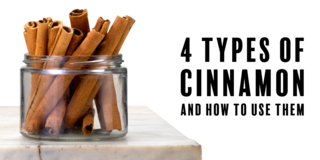4 Types of Cinnamon
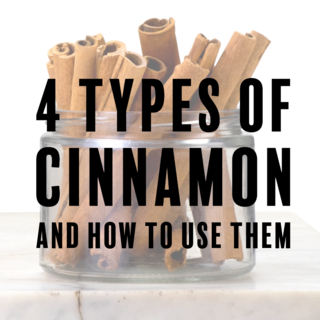
4 Types of Cinnamon
Warm, comforting, and welcoming, the woodsy, spicy scent of cinnamon practically defines the idea of baked goods. With virtually no tart notes and an inherent depth, cinnamon is often perceived as sweet, and lends itself naturally to sugary applications—who doesn’t love cinnamon sugar on toast in the morning? However, cinnamon can also be used in savory dishes, mellowing out gamy flavors in stews or roasts, or brightening up a heavy dish with its lilting aroma. According to Lior Lev Sercarz, New York-based spice guru and author of the book Spice Companion, cinnamon “…brings sweetness to savory foods and a savory element to desserts. Because of its clove-like scent and warm flavor, it can trick our brains into thinking that dishes made with cinnamon have sugar even if there is none.”
Cinnamon is the inner bark of several different species of laurel tree, all of which are harvested and dried until the bark rolls in on itself. The sticks of bark are known as quills, and there are marked differences between Ceylon cinnamon quills and Cassia cinnamon sticks. Ceylon cinnamon’s scientific name is Cinnamomum zeylanicum, which literally translates as “Cinnamon from Ceylon”, the former name of Sri Lanka, an island located just off the tip of the Indian subcontinent. It is also known as Cinnamomum verum, or “true cinnamon”, which causes a tremendous amount of confusion when tracing the history of cinnamon. This cinnamon is more delicate and papery, with multi-layered quills that are somewhat crumbly. There are three more species of cinnamon: Cinnamomum Cassia, also called Chinese cinnamon or Cassia; Cinnamomum burmannii, originally from Myanmar, which was once called Burma, also known as Korintje, Java, or Indonesian cinnamon; and Cinnamomum loureiroi, or “cinnamon from laurels”, which is also called Vietnamese or Saigon cinnamon. There is some variation in flavor among these three trees, but the harvested bark is thicker and more pungent, which makes for harder quills. These four kinds of trees are all related and are all “true” cinnamons, though there are differences in characteristics between the varieties.
Table of Contents
How can you tell the quality of cinnamon?
What is better, cinnamon sticks or powder?
Can you make cinnamon powder out of cinnamon sticks?
What is the difference between cinnamon and Vietnamese cinnamon?
What is the best type of cinnamon?
How do I know if my cinnamon sticks are Ceylon or Cassia?
How can you tell the quality of cinnamon?
The quality of cinnamon is largely dependent on your personal taste, though this question often initially centers on whether or not Ceylon cinnamon is better than the other varieties of cinnamon. As mentioned, Ceylon cinnamon is the more physically delicate variety, and its flavor is also less assertive. Ceylon cinnamon delivers a light, clove-y flavor and citrus top notes, with little pungency. Cassia cinnamons are more pungent, with a strong wood-clove-musk-pepper flavor. There is a vocal contingent of cinnamon fans who passionately claim that the crumbly quills of Ceylon are superior to the brassier Cassia, but it still comes down to preference.
You can maintain higher quality overall by buying ground cinnamon from a reputable supplier who won’t add cheap fillers to the grind in order to pad their profit, or you can grind your own quills into powder.
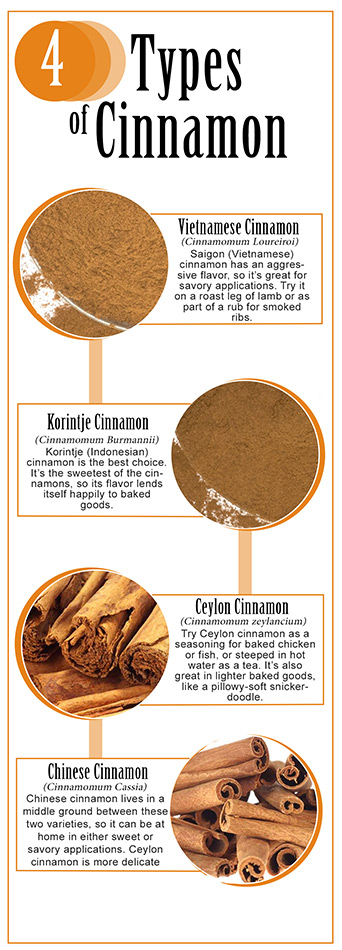
What is better, cinnamon sticks or powder?
Whether you choose cinnamon sticks or cinnamon powder depends on what you’re making. Whole cinnamon sticks are better for steeping in hot liquids, like mulled cider or wine or the Vietnamese soup pho. Sticks infuse the liquids with their essence without adding extra texture, and can be removed once the proper flavor has been achieved. Cinnamon powder is a better choice when you need to add the cinnamon directly to a recipe.
If you’re baking, Korintje (Indonesian) cinnamon is the best choice. It’s the sweetest of the cinnamons, so its flavor lends itself happily to baked goods. Saigon (Vietnamese) cinnamon has an aggressive flavor, so it’s great for savory applications. Try it on a roast leg of lamb or as part of a rub for smoked ribs. Cassia cinnamon lives in a middle ground between these two varieties, so it can be at home in either sweet or savory applications. Ceylon cinnamon is more delicate and floral. It is suited for baking or savory foods, but they should be lighter types of food. Try Ceylon cinnamon as a seasoning for baked chicken or fish, or steeped in hot water as a tea. It’s also great in lighter baked goods, like a pillowy-soft snickerdoodle.
Can you make cinnamon powder out of cinnamon sticks?
Yes, you can most certainly make cinnamon powder from cinnamon sticks; that’s all ground cinnamon should be. Ceylon cinnamon is soft and crumbly, so it grinds easily. It can probably be broken down in a mortar and pestle if that’s what you have, though a motorized coffee grinder is easier. Cassia cinnamon is cut from a thicker bark and has a tougher quill; if you want to grind that, we definitely recommend using a grinder with a motor and sharp blades to break through the quills. Whether it’s Ceylon or Cassia, the quills should be snapped into smaller pieces before putting them in a grinder, to start the process along. The grinder doesn’t have to be a high-end, bells-and-whistles piece of equipment. A sturdy little coffee grinder that you dedicate to use for spices will work just fine.
What is the difference between cinnamon and Vietnamese cinnamon?
Vietnamese cinnamon, also known as Saigon cinnamon, is a varietal of Cassia cinnamon. It has the highest amount of volatile oil of all the cinnamons and so it’s got the most aggressive flavor, peppery and bold, and can be bitter if it’s used in abundance. Like the other Cassia varietals, it’s got thick, sturdy quills so it can be difficult to grind. Most commercially available cinnamon, if its place of origin isn’t marked and is just labeled “Cinnamon”, is Indonesian cinnamon, which is the mildest and sweetest of the Cassia cinnamons. Ceylon cinnamon, aside from the obvious physical differences, will always be marked on the label.
What is the best type of cinnamon?
The “best” type of cinnamon depends on what you’re looking for. Ceylon is wonderful if you want cinnamon that’s delicate, with a citrusy-floral aspect to lighten the woodsy notes. Chinese Cassia cinnamon has straightforward, up-front cinnamon flavor. Saigon cinnamon is bold and more aggressive, and Indonesian cinnamon is the sweetest and most approachable of the Cassia varieties. Ceylon cinnamon is easiest to grind, if you want to do that at home. You also have to consider how you’re going to use the cinnamon. Will you be making cider, or baking cookies? Will you be cooking a traditional Mexican dish, which is traditionally made with Ceylon cinnamon? Or will you be making a savory Thai curry, which would call for Indonesian cinnamon?
What is Korintje cinnamon?
Korintje cinnamon is also known as Indonesian cinnamon, and it’s the standard-bearer for commercial cinnamon use and food preparation in the United States. The sweetest and most versatile version of Cassia cinnamon, Indonesian cinnamon became a hot commodity in the 17th century, when the Dutch controlled the spice trade around south east Asia. The name comes from the Kerinci Regency, an area on the island of Sumatra, which is part of Indonesia. This region was particularly well suited for the Cinnamomum burmannii tree; the Dutch cultivated this tree there and morphed “Kerinci” into the Dutch “Korintje”, establishing it as one of their products as they solidified their dominance of the cinnamon trade.
How do I know if my cinnamon sticks are Ceylon or Cassia?
Ceylon cinnamon and Cassia cinnamon are easy to tell apart when they’re in whole, unground quills. A quill of Ceylon cinnamon will have multiple, thin layers that look delicate and almost papery. It’s also a little bit lighter in color, looking almost tan, instead of ruddy brown. A quill of any of the Cassia varieties will be thicker. It will not curl on itself nearly as much; there will be one, or possibly two, curls in a Cassia cinnamon stick, rather than exhibit the many layers of curls like Ceylon displays. When they’re ground they look nearly identical.
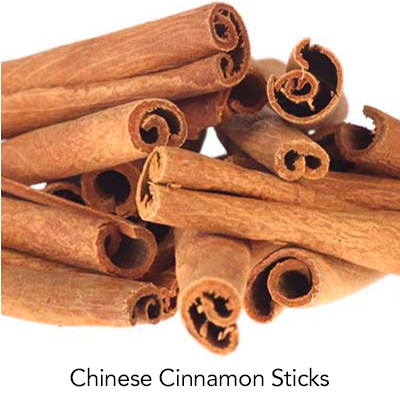
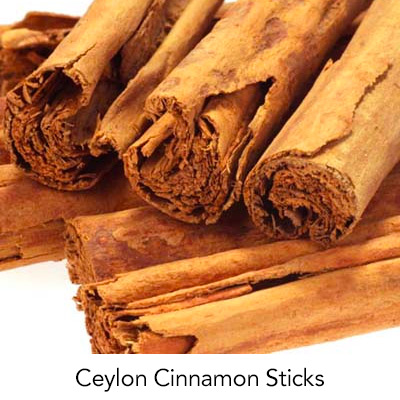
How do you identify Ceylon cinnamon?
The easiest way to check if you have Ceylon cinnamon is simply to read the label. Since it is not as frequently used in the United States and it costs more than the other cinnamons, Ceylon cinnamon will always be specifically labeled, so the consumer understands the price. If you’re in an ethnic grocery store you may see it labeled as Canela; that is the Spanish name for Ceylon cinnamon, and it was named because the round quill resembled a little cannon. Look for quills that have multiple, thin layers of bark and are lighter in color, more tan than red. If they are ground, take a small taste. Ceylon cinnamon has a gentler, softer flavor with notes of citrus blossom, rather than the standard cinnamon flavor that leaps out at you and has peppery notes. Remember, if it just says “Cinnamon” it will be a Cassia-type of cinnamon, and will most likely be Indonesian.
Hungry for more information?
Holiday Spice Guide
Most Popular Spices by Cuisine
5 Reasons to Have Cinnamon Sticks On Hand

